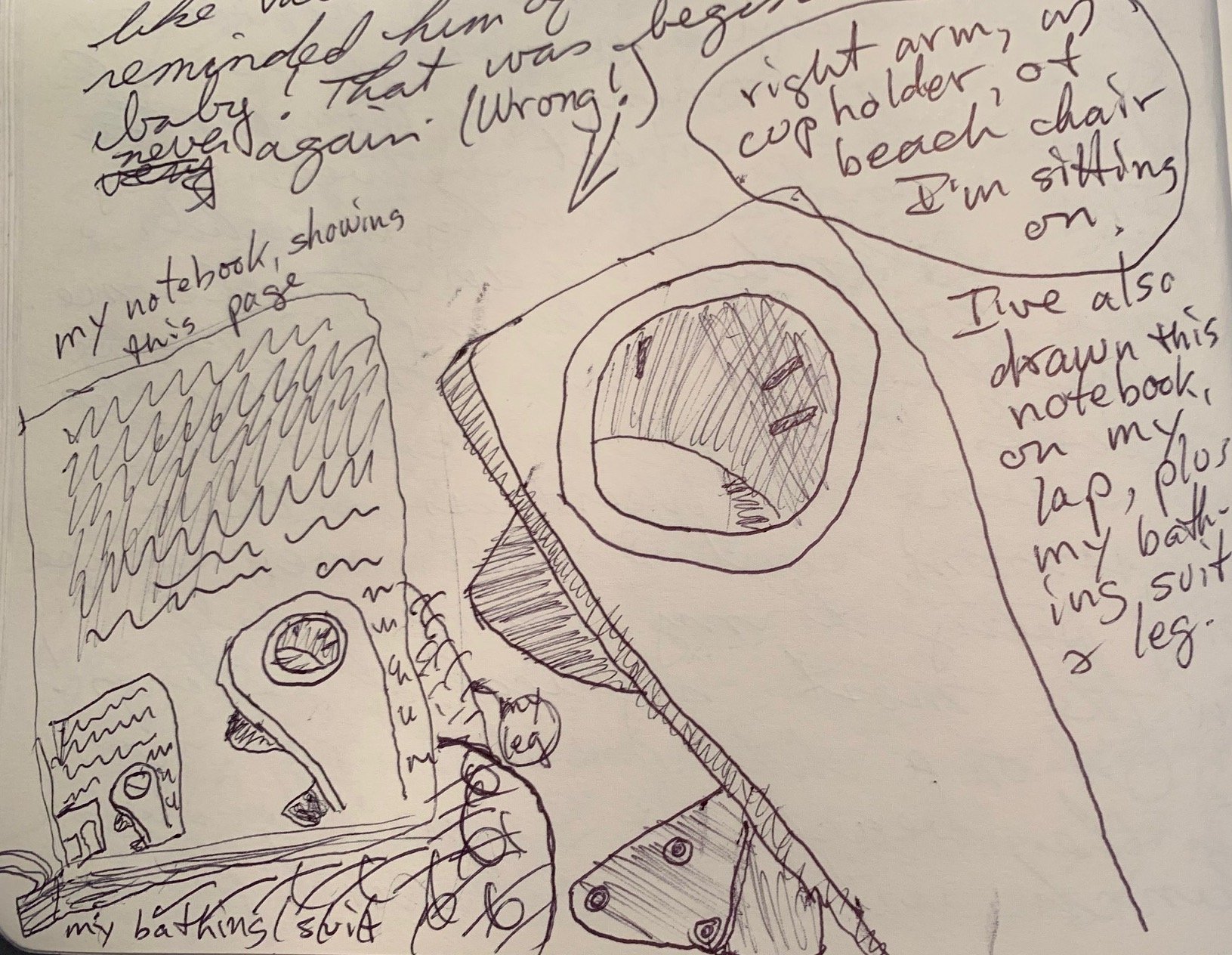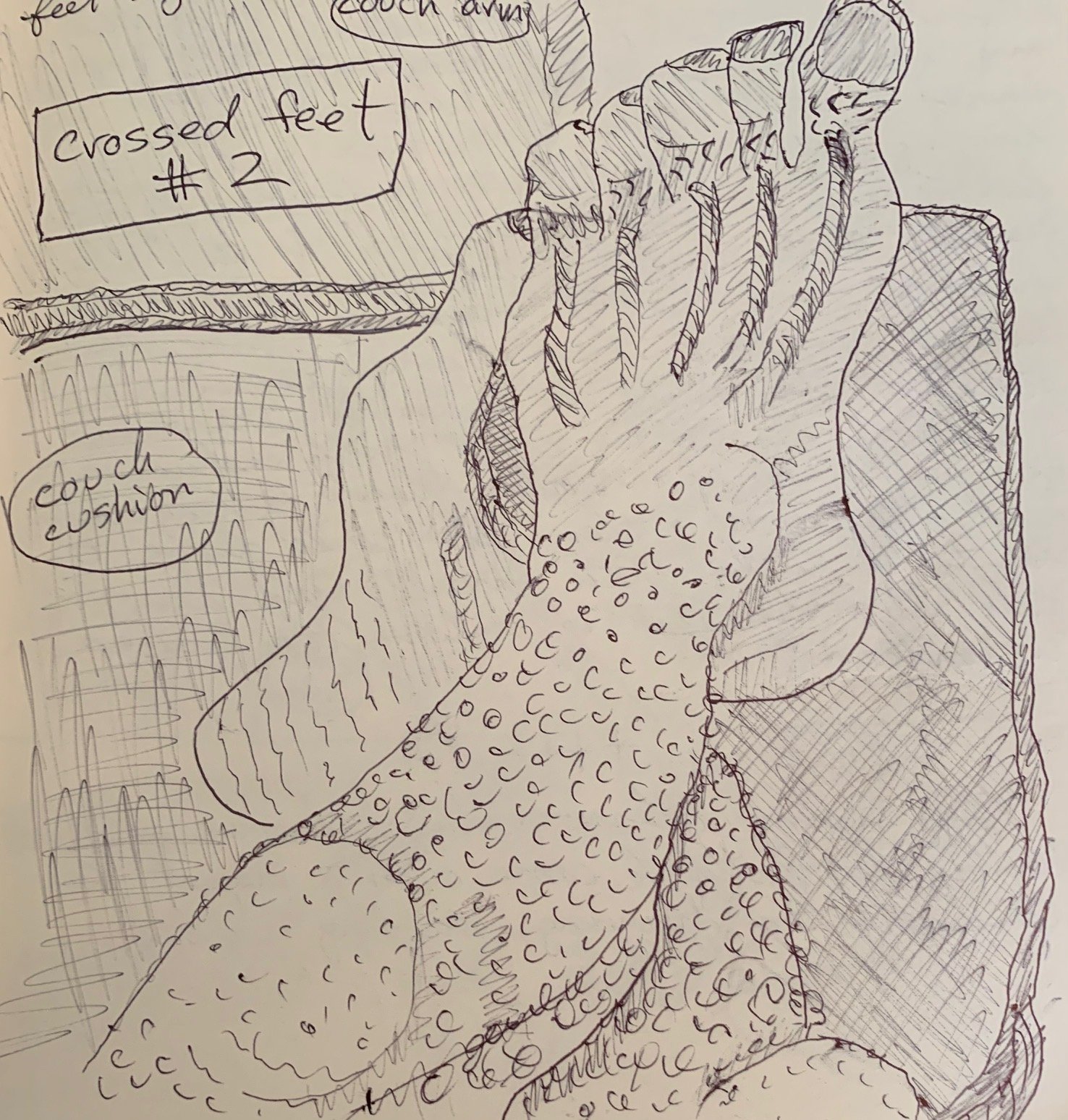Drawing a Pen with the Same Pen and Other Strange Loops
Carol Croland, the girlfriend of my old friend Bill Mathews (who is an actual, superb artist), gave me me this journal. Thanks Carol!
August 29, 2023. The friend of a friend gave me a writing journal as a birthday present. On the journal’s mottled black cover is printed, in gold ink, “The CREATIVE RAMBLINGS of a RESTLESS MIND.” Haha.
I took the journal with me this month when my girlfriend “Emily” and I stayed in a cottage near the sea. Sipping coffee in the morning, I jotted down a thought or two in the journal, but my ramblings weren’t very creative. On a whim I began drawing on the journal’s blank pages, even though I’ve never really drawn before.
I started with simple things in my line of sight: a table, lamp, mug, iPhone. Emily, I shit you not, said my sketch of a chair (below) reminded her of Van Gogh. Emboldened, I drew my feet, stretched out before me on the couch. Feet are complicated! All those tendons and veins, nails and knobs.
I was drawing on the beach when things got loopy. Waves, pebbles and seaweed defeated me; my sketches looked like random scribbles. So I drew the arm of the beach chair on which I was sitting. The arm is a wedge of molded plastic with a cupholder. Easy. Then I drew the right-hand page of the open journal in my lap, on which I had just drawn the chair-arm. I wasn’t trying to be cute, I was just drawing what I saw.
At first, I left the drawn page, or mini-page, blank. But the real page was no longer blank, because I’d drawn the mini-page and chair-arm on it. So I drew a mini-mini-page and arm on the mini-page, and a still-smaller page and arm on that mini-mini-page (below). I’d stumbled on an infinite regress, or “strange loop,” of the kind that obsesses Douglas Hofstadter, author of Gödel, Escher, Bach. A strange loop is something that does something to itself.
I drew the arm of the beach chair (with cupholder) in which I was sitting, and the open journal in my lap, because drawing waves was too hard.
Back in the cottage, things got even loopier when I drew a pen sitting on the table beside me. Inscribed on the pen was “Great Point Properties,” the company that manages the cottage. Again, I wasn’t trying to be meta, I just liked the pen’s shape. Then it occurred to me that the pen was both the object and instrument of my drawing. Hmm.
I happened to be drawing the Great Point pen with an identical Great Point pen. What if I only had one pen? How would I draw it? I could take a photo of the pen with my iPhone and draw the photo with the pen. Barring that, I’d have to keep switching back and forth between studying the pen and drawing with it. I tried doing just that, drawing the Great Point pen with the very same pen, and it was tricky.
I’d tripped over another strange loop--a pen drawing itself--and a metaphor: Drawing a pen with that same pen is like observing your mind with your mind, except the latter is much trickier. You may think observing your own mind is straightforward, because you do it all the time, whenever you introspect. There are even formalized introspection techniques, like psychotherapy and meditation.
But using your mind to gain an objective view of your mind is difficult, perhaps impossible. I don’t have a separate mind with which to contemplate and “draw,” as it were, my mind. Nor can I take a photo of my mind and draw that. Not even the most hard-core materialist—not even Daniel Dennett, I’m guessing--claims that a magnetic-resonance scan of your brain depicts your mind.
Plus, your mind keeps changing moment by moment. Imagine how hard it would be to draw a pen if it wobbled like waves. Worse, observation can obliterate what you want to observe, as William James pointed out more than a century ago in “The Stream of Consciousness.” Studying thoughts through “introspective analysis,” James said, is like “seizing a spinning top to catch its motion” or “trying to turn up the gas quickly enough to see how the darkness looks.”
Some writers, notably Virginia Woolf and James Joyce, excel at simulating our inner life. But they can’t depict thoughts the way an artist depicts chairs or waves. Woolf and Joyce imagine thoughts, and then they render these imaginings in words, taking us even farther from actual, raw, moment-by-moment thoughts. Creating persuasive stream-of-consciousness literature requires lots of artistry, that is, trickery, far more than drawing a pen with the same pen.
Just before my seaside vacation, I went to a meditation workshop at the Omega Institute in upstate New York. The teacher, Loch Kelly, specializes in “effortless mindfulness.” He kept telling us there is no problem to be solved; all we have to do is be. Kelly was just trying to calm our restless minds, to get us to see that we’re already enlightened. But I thought, No problem to be solved? Are you kidding?
Douglas Hofstadter thinks we, and reality as a whole, consist of strange loops within strange loops. [See Hofstadter’s Correction.] That strikes me as right. Physicists think they are carrying out straightforward observations of nature, which they turn into mathematical models. Some models are impressive; they enable us to build H-bombs and whatnot. But one of the best models ever, quantum mechanics, blurs the boundary between what physicists observe and the instruments with which they observe, including their minds. Physicists are doing something akin to drawing a Great Point pen with the same Great Point pen.
All these strange loops are tying me up in knots. I should chill out by drawing again. Drawing absorbs me, it’s better than meditation. I like paying close attention to, and trying to render, the shapes and shadings of everyday things. Maybe I’ll draw my feet again. Monet had his water lilies, I’ve got my feet.
Hofstadter’s Correction: In 2025 Hofstadter emailed me: “You wrote: Douglas Hofstadter thinks we, and reality as a whole, consist of strange loops within strange loops.’ That’s not accurate. What’s accurate is that I think that a human soul or self is a strange loop. I never said any such thing about reality as a whole.”
Further Reading:
I get into the limits of introspection in “The Dark Matter Inside Our Heads” and “Is Self-Knowledge Overrated?”
I profile Douglas Hofstadter in my free online book Mind-Body Problems, and I delve into quantum paradoxes in My Quantum Experiment.
I take a shot at stream-of-consciousness writing in my quasi-fictional memoir Pay Attention: Sex, Death, and Science.






